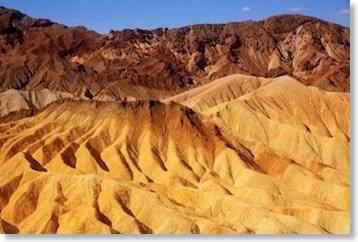866-295-4143, fbns@wayoflife.org

Indeed, he did. It was largely on the basis of uniformitarianism that the Bible was rejected. If the earth is millions of years old and the strata represent vast eons of time, then the Bible is wrong. (The attempts to reconcile uniformitarian geology with the Bible, such as the gap theory and the day-age theory, are not based on sound exegesis.)
Interestingly, by the mid-20th century, uniformitarianism was being rejected by evolutionists themselves.
“The geologic community gave up substantive uniformitarianism long ago” (David Young, Christianity and the Age of the Earth, p. 142).
In 1956, P. D. Crynine called it “a dangerous doctrine” (Journal of Palaeotology, 30: 1003-1004). In 1965, Stephen Jay Gould said it should be abandoned (“Is Uniformitarianism Necessary?” American Journal of Science, 1965, 263: 223-228). In 1979, S. A. Austin called it “a doctrine that needs rethinking” (Compass, 56: 29-45).
Uniformitarinism is under assault from the evidence that things formerly thought to have required a slow process of thousands or millions of years can actually be made quickly.
Consider some examples:
Sedimentation
Guy Berthault conducted extensive laboratory experiments demonstrating that sediments naturally and quickly form layers in moving water and that the sediment is sorted in the same manner that is found in the “geological column.” The results of this research was published in the late 1980s and presented to the National Congress of Sedimentologists at Brest in 1991.
“What Berthault found was that when the sediments settled on the bottom they recreated the appearance of the original rocks from which they had come. But the strata were not formed by the deposition of a succession of layers as had been formerly assumed. Instead, the sediments settled on the bottom more or less immediately, but the fine particles were separated from larger particles by current flow, giving the appearance of layers. Moreover, the lamination was found to have a thickness that was independent of the length of time taken to deposit that sediment--another fundamental assumption of classic geology. ‘It follows,’ observed Berthault, ‘that no deduction of the duration of sedimentation can be made by simple observation of rock laminae’” (Milton, Shattering the Myths of Darwinism, p. 77).
The laboratory work was supplemented by field observations from Mount St. Helens and other places, proving that phenomena such as the formation of canyons previously thought to require thousands or millions of years can occur in a matter of days or even hours.
Mudstone formation
In 2007 the following article appeared in Science magazine debunking the long held view that mudstones require a slow accumulation of deposits:
“Mudstones make up the majority of the geological record. However, it is difficult to reconstruct the complex processes of mud deposition in the laboratory, such as the clumping of particles into floccules. Using flume experiments, we have investigated the bedload transport and deposition of clay floccules and find that this occurs at flow velocities that transport and deposit sand. Deposition-prone floccules form over a wide range of experimental conditions, which suggests an underlying universal process. ...
“Because mudstones were long thought to record low-energy conditions of offshore and deeper water environments, our results call for reevaluation of published interpretations of ancient mudstone successions and derived paleoceanographic conditions. A key issue in mudstone sedimentation is flocculation...
“The notion is widely held that slow-moving currents or still water are a prerequisite for substantial mud deposition because shear stress in swift-moving currents disrupts previously formed fragile floccules and prevents their deposition, but our observations suggest an alternative mode of mud deposition that apparently left its imprint in the rock record. Mudstones constitute up to two-thirds of the sedimentary record and are arguably the most poorly understood type of sedimentary rocks. ...
“Our observations do not support the notion that muds can only be deposited in quiet environments with only intermittent weak currents. ... Many ancient shale units, once examined carefully, may thus reveal that they accumulated in the manner illustrated here, rather than having largely settled from slow-moving or still suspensions. This, in turn, will most likely necessitate the reevaluation of the sedimentary history of large portions of the geologic record” (Juergen Schieber, John Southard, Kevin Thaisen, “Accretion of Mudstone Beds from Migrating Floccule Ripples,” Science, Dec. 14, 2007).
These scientists are calling for a re-evaluation of the geology of the entire earth based on scientific research that shows that mudstone is created by rapidly flowing water. This would reasonably cause them to reconsider the Bible’s record of a global flood, but they refuse to do that because of their bias.
Stalagmites
It was long thought that stalagmites were formed at an incredibly slow rate and that this proved the ancient age of caves. In fact, stalagmites were used as an icon of evolution for many decades. It is now known that they can form very quickly.
“In Sequoia Caverns, stalactites protected from tourists from 1977-1987 grew 10 inches or 1 inch / year. At this rate they could have grown 300 ft in just 3600 years. The picture at right is of a bat discovered in 1953 in a stalagmite, in Carlsbad Caverns, New Mexico. The stalagmite grew around the bat before it could decay or be eaten. The temperature where this bat is found is just above freezing at a constant 40o F. The water dripping from the stalactite above it is vary salty. This would impede but not prevent decay. Also it would not prevent the bat from being eaten. So this stalagmite still had to form quite rapidly, certainly far less than 5,000 years” (http://creationwiki.org/Stalactites_and_Stalagmites).
Petrified trees
It has also been learned that wood can petrify quickly and that formations such as those in the Petrified Forest National Park of Arizona did not necessarily take long periods of time to form.
“Indeed, as part of a study of the petrified wood in the Petrified Forest National Park of Arizona, an experiment was conducted in which blocks of wood were placed in hot alkaline springs in the Yellowstone National Park to test the rate at which silica is deposited in the cellular structure of the wood. The measured rate was between 0.1 and 4.0 mm/year. Other similar experiments have been conducted in laboratories. Furthermore, as a result of testing for petrification in a Japanese volcanic spring, it was concluded that petrified wood in ancient volcanic ash beds in sedimentary strata in volcanic regions could have thus been silicified by hot flowing ground water with high silica content in a fairly short period of time, in the order of several tens to hundreds of years. Such rapid petrification of wood is confirmed by many field observations of trees cut down by early settlers in Australia that were subsequently buried in the soil, then later dug up and found to be petrified, including the axe marks” (Andrew Snelling, Earth’s Catastrophic Past, vol. 2, p. 958).
Coal
Evolutionists use the massive coal beds that are scattered throughout the earth as evidence of an ancient age of the earth, because it is believed that millions of years were required for their formation. It has been demonstrated scientifically that this is a false assumption. Andrew Snelling, Ph.D. in geology, writes:
“Laboratory experiments have been quite successful in artificially producing coal-like materials relatively rapidly, under conditions designed to simulate those present in sedimentary basins where coal measure strata have accumulated. ...
“A research team at the Argonne National Laboratory in Illinois made insoluble material resembling coal macerals (components) by heating lignin with clay minerals at 150 degrees C for 2 to 8 months in the absence of oxygen. It was discovered that the longer heating times produced higher rank coal macerals, and the clays appeared to serve as catalysts that speed the coalification reactions...
“More recent coalification experiments have tried to more closely simulate the natural geologic conditions, with temperatures of only 125 degrees C in both lithostatic and fluid pressures equivalent to burial under 1,800 meters of wet sediments, yet maintained as a geologically open system which allowed by-products that may retard coalification to escape. In that experiment, after only 75 days, the original peat and petrified wood had been transformed into coalified peat and coalified wood, comparable chemically and structurally to lignite and coalified wood from the same geographical region as the original peat and petrified wood samples” (Earth’s Catastrophic Past, vol. 2, pp. 584-586).
Canyons and Stratification
The explosion of Mt. Saint Helens in 1980 and the subsequent transformation of the landscape has provided a ready laboratory to study the formation of canyons and stratification.
A canyon 700 feet deep and several miles long was carved (at some places even into solid bedrock) by the violent mudflows. One series of canyons are one fortieth the scale of the Grand Canyon in Arizona, with individual canyons having depths of up to 140 feet, with sheer cliffs of up to almost 100 feet (Earth’s Catastrophic Past, vol. 2, p. 718).
The blast also caused the formation of up to 600 feet of strata, caused by landslides, flowing water from Spirit Lake, pyroclastic flows, mudflows, air fall, and stream water.
“In less than five hours, 25 feet of very extensive strata had accumulated, even containing thin laminae and cross-bedding from 1 mm thick to >1 meter thick, each representing just a few seconds to several minutes of accumulation” (Earth’s Catastrophic Past, vol. 2, p. 724).
It is evident that large canyons and massive stratification can occur very quickly and that these do not require millions of years to form.
The uniformitarian model has also been undermined by the evolutionists themselves through the newer theories that the world has witnessed a series of global catastrophes, such as the one that allegedly killed off the dinosaurs. The fossil section of the Field Museum in Chicago is arranged around a series of five “mass extinctions” that supposedly wiped out most life forms. These are said to have been caused by things such as shifting continents, volcanic activity, meteors, and “global warming.”
If mass extinctions were caused by dramatic, global events, it is obvious that the earlier view of uniformitarianism was fundamentally wrong, but it was this very theory that caused scientists to reject the Bible in the first place! The fact that they won’t admit that a terrible mistake was made and that the Bible needs to be reconsidered is evidence that we are not dealing with rational, empirical science but with religion disguised as science.
- Receive these reports by email
- www.wayoflife.org
______________________
Sharing Policy: Much of our material is available for free, such as the hundreds of articles at the Way of Life web site. Other items we sell to help fund our expensive literature and foreign church planting ministries. Way of Life's content falls into two categories: sharable and non-sharable. Things that we encourage you to share include the audio sermons, O Timothy magazine, FBIS articles, and the free eVideos and free eBooks. You are welcome to make copies of these at your own expense and share them with friends and family. You may also post parts of reports and/or entire reports to websites, blogs, etc as long as you give proper credit (citation). A link to the original report is very much appreciated as the reports are frequently updated and/or expanded. Things we do not want copied and distributed are "Store" items like the Fundamental Baptist Digital Library, print editions of our books, electronic editions of the books that we sell, the videos that we sell, etc. The items have taken years to produce at enormous expense in time and money, and we use the income from sales to help fund the ministry. We trust that your Christian honesty will preserve the integrity of this policy. "For the scripture saith, Thou shalt not muzzle the ox that treadeth out the corn. And, The labourer is worthy of his reward" (1 Timothy 5:18). Questions? support@wayoflife.org
Goal:Distributed by Way of Life Literature Inc., the Fundamental Baptist Information Service is an e-mail posting for Bible-believing Christians. Established in 1974, Way of Life Literature is a fundamental Baptist preaching and publishing ministry based in Bethel Baptist Church, London, Ontario, of which Wilbert Unger is the founding Pastor. Brother Cloud lives in South Asia where he has been a church planting missionary since 1979. Our primary goal with the FBIS is to provide material to assist preachers in the edification and protection of the churches.
Offering: Offerings are welcome if you care to make one. If you have been helped and/or blessed by our material offerings can be mailed or made online with with Visa, Mastercard, Discover, or Paypal. For information see: www.wayoflife.org/about/makeanoffering.html.





